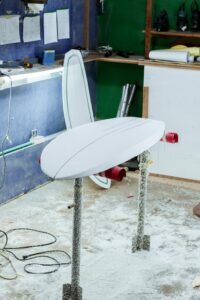Posted by Jeb Brinkley | 12.20.2024 | Uncategorized
The Art of Surfboard Building: Exploring the Materials in our Boards
Surfboards are more than just tools for riding waves; they are a fusion of artistry, science, and craftsmanship. Whether you’re a seasoned surfer or just starting out, understanding the materials used in surfboard construction can deepen your appreciation for these incredible creations. Let’s dive into the various materials that shape the surfboards we love.
- Foam Cores: The Heart of the Surfboard

The foam core is the foundation of every surfboard, determining its weight, buoyancy, and performance. Here are the most common types
Polyurethane Foam (PU)
- Description: PU foam has been a staple in surfboard construction since the 1950s.
- Advantages: Easy to shape, provides a smooth ride, and pairs well with polyester resin.
- Downside: Less eco-friendly and heavier than other options.
- Best For: Traditional shortboards and longboards.
Expanded Polystyrene Foam (EPS)
- Description: EPS foam is lightweight and environmentally friendly.
- Advantages: Highly buoyant and works well with epoxy resin.
- Downside: The bead-like structure can make shaping more challenging.
- Best For: Performance boards and eco-conscious surfers.
- Resins: The Protective Shell
Resin coats the foam core, providing strength, durability, and water resistance.
Polyester Resin
- Description: The traditional choice for surfboards.

- Advantages: Affordable, easy to work with, and produces a glossy finish.
- Downside: Less flexible and more prone to cracking compared to epoxy.
- Best For: Classic PU foam boards.
Epoxy Resin
- Description: A modern alternative gaining popularity.
- Advantages: Stronger, lighter, and more flexible than polyester resin.
- Downside: Higher cost and requires specific shaping techniques.
- Best For: EPS foam boards and high-performance designs.
- Fiberglass Cloth: Adding Strength and Flex
Fiberglass cloth is layered over the foam core and saturated with resin to create a strong yet flexible shell.
- Types of Fiberglass:
- 4 oz cloth: Lightweight and ideal for performance boards.
- 6 oz cloth: Heavier and more durable, often used on longboard

- Wood: Classic Style and Modern Performance
Wood has been used in surfboard construction for centuries, from traditional Hawaiian alaia boards to modern designs.
Balsa Wood
- Description: Lightweight and highly buoyant.
- Advantages: Offers a natural aesthetic and sustainable option.
- Downside: Less durable than synthetic materials.
- Best For: Retro and eco-friendly boards.
- Alternative Materials: Innovation in Surfboard Design
Carbon Fiber
- Description: Used in high-performance boards for added strength and reduced weight.
- Advantages: Increases responsiveness and durability.
- Downside: Expensive.
Cork
- Description: A sustainable option for deck pads or full-board construction.
- Advantages: Eco-friendly, shock-absorbing, and provides excellent grip.
Recycled Materials
- Description: Boards made from recycled foam, resins, or plastics.
- Advantages: Great for reducing environmental impact.
- Best For: Surfers committed to sustainability.
Final Thoughts
The materials used in surfboard construction are as diverse as the waves themselves. From traditional PU foam to innovative cork and carbon fiber designs, each material offers unique benefits and characteristics. Whether you’re carving waves on a high-tech shortboard or cruising on a classic longboard, the choice of materials plays a critical role in your surfing experience.
Next time you’re out in the lineup, take a moment to appreciate the craftsmanship and innovation that went into your board—it’s more than just a tool; it’s a work of art designed to dance with the ocean.
What’s your favorite type of surfboard? Let us know in the comments below!







 RENTALS
RENTALS LESSON
LESSON CAMPS
CAMPS ABOUT
ABOUT SHOP
SHOP